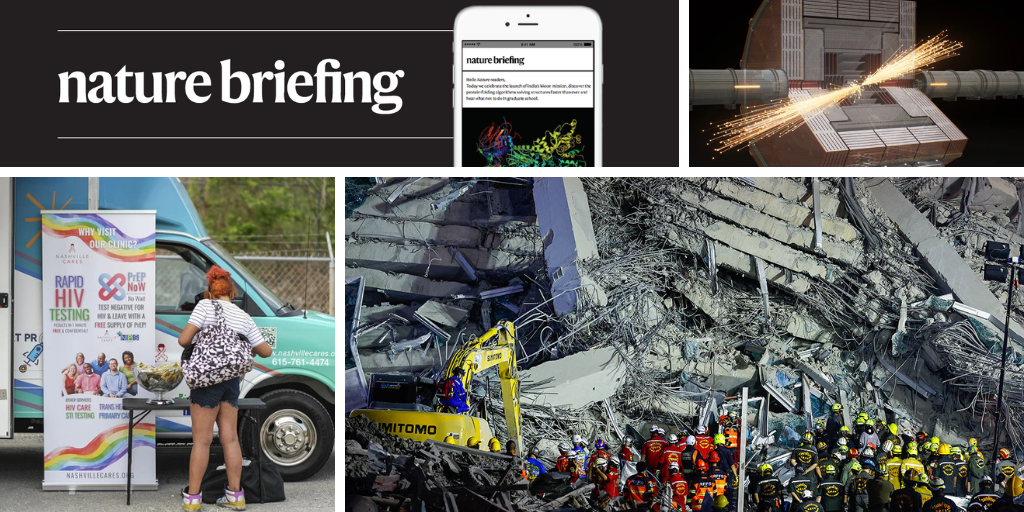You have full access to this article via your institution.
Hello Nature readers, would you like to get this Briefing in your inbox free every day? Sign up here.

Credit: Daniel Ceng/Anadolu via Getty
The magnitude-7.7 earthquake that hit Myanmar on 28 March appears to have been a rare type known as supershear — in which the energy of a rupture moves exceptionally fast through the ground, amplifying the destruction. If that explanation is correct, then the geological fault that broke during the quake — the massive Sagaing fault, which runs north–south through the heart of Myanmar — might have ruptured over 400 kilometres or more. In the coming days, researchers might be able to confirm this by looking at satellite imagery of the region taken before and after the quake.
CERN’s ambition to build an accelerator three times as large as the Large Hadron Collider took a significant step forward this week with the release of a massive feasibility study for the project — though the report didn’t touch on funding. The feasibility report into a 91-kilometre ‘Future Circular Collider’ (FCC) will feed into a review of CERN’s long-term strategy that is due to conclude next year. “If approved and implemented, the FCC could become the most extraordinary instrument ever built by humanity to study the laws of nature at the most fundamental level,” said Fabiola Gianotti, CERN’s director general.
A drug called nitisinone that is already approved in the United States to treat metabolic disorders can make human blood toxic to mosquitoes. Female Anopheles gambiae mosquitoes — which transmit malaria — died within 12 hours of consuming blood taken from three people who regularly take nitisinone. The antiparasitic drug ivermectin also poisons mozzies, but nitisinone appears to kill faster, stick around in human blood longer, and is possibly safer for people and other insects.
Reference: Science Translational Medicine paper
The administration of US President Donald Trump has fired many staff at one of the federal offices aimed at ending the nation’s HIV epidemic, the US Office of Infectious Disease and HIV/AIDS Policy, and has cut hundreds of grants funding HIV and AIDS research. The changes leave researchers bewildered: during Trump’s first presidency, his administration launched a plan to eradicate HIV in the United States by 2030. Among the terminated grants were two supporting the Adolescent Trials Network, which conducts research on HIV prevention and treatment for young people. “We’ve built this over 25 years,” says health researcher Lisa Hightow-Weidman, one of the network’s main investigators. “And it was destroyed with an e-mail in a day.”
Bulgarian politician Ekaterina Zaharieva is the European Union’s new research commissioner in charge of, among other things, shaping the successor to the enormous €93.5-billion (US$101-billion) Horizon Europe research programme. When asked if Europe is hoping to attract disaffected US scientists, she says, “yes, very much”. But “if it’s not a good place to do research, they will not come”, she notes. Zaharieva says she will focus on promoting scientific freedom and cutting grant bureaucracy, as well as increasing Horizon’s reach to even more countries, such as India.
Features & opinion
Psychologist Jonathan Haidt’s blockbuster book The Anxious Generation suggests that increasing time spent on smartphones, at the expense of socialising and play, is rewiring adolescent brains and driving soaring rates of mental illness. Others say research does not show a large effect of these technologies on teen mental health. At the heart of the dispute is a large, complex and often conflicting body of evidence that different researchers interpret in different ways. And some worry that the focus on phones risks distracting scientists and policymakers from other important, but harder-to-tackle problems. “We have young people in crisis, and part of it might be technology,” says Amy Orben, who studies digital mental health. “But we also have other areas that we really, truly know influence mental health that aren’t getting near the time they need.”
Image of the week

Mathematicians have solved a 122-year-old puzzle of how to turn a triangle into a square. (Scientific American | 4 min read) (Jen Christiansen; Source: “Animation of Dudeney’s Dissection Transforming an Equilateral Triangle to a Square,” by Mark D. Meyerson (reference))
Today I’m getting language-learning tips from linguist Luis Miguel Rojas-Berscia, the world’s first appointed ‘city linguist’, who works in the Dutch city of Nijmegen. Originally from Peru, Rojas-Berscia studies the local Nimweegs dialect and says he’s lost count of how many languages he speaks but estimates it’s nearly 20. He says that reading children’s books is a great place to start, but that learning a language needs immersion and conversation — and a passion for the process.
While I immerse myself in the dulcet tones of my singular second language, why not send me your feedback on this newsletter? Your e-mails are always welcome at [email protected].
Merci de m’avoir lue,
Flora Graham, senior editor, Nature Briefing
Want more? Sign up to our other free Nature Briefing newsletters:
• Nature Briefing: Careers — insights, advice and award-winning journalism to help you optimize your working life
• Nature Briefing: Microbiology — the most abundant living entities on our planet — microorganisms — and the role they play in health, the environment and food systems
• Nature Briefing: Anthropocene — climate change, biodiversity, sustainability and geoengineering
• Nature Briefing: AI & Robotics — 100% written by humans, of course
• Nature Briefing: Cancer — a weekly newsletter written with cancer researchers in mind
• Nature Briefing: Translational Research — covers biotechnology, drug discovery and pharma


